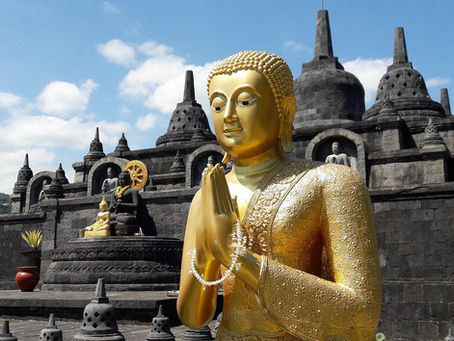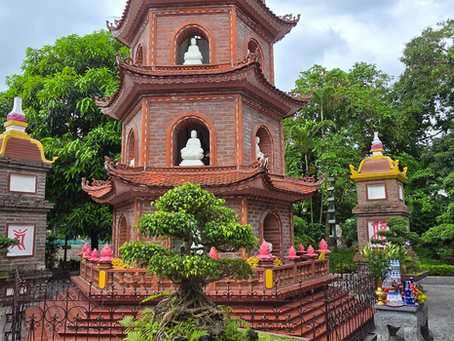top of page

GLOBAL SHANANIGANS

Search


Baan Dam - The Black House Museum
In the quiet north of Chiang Rai, where the air hums with memory and shadow, stands The Black House Museum, the unique brainchild of famed Thai artist Thawan Duchanee. This open-air gallery unfolds across tranquil gardens, where forty haunting structures rise like dark prayers. Within their walls, bones, taxidermy, and sacred art merge into a single, unsettling vision, a labyrinth of charred timber and silence, less a museum than a descent into the artist’s soul.
Shannon


Railay Beach
Hidden behind towering limestone cliffs on Thailand’s Andaman Coast, Railay Beach is a secluded paradise reachable only by boat. Nestled between Krabi and Ao Nang, this striking peninsula draws climbers to its rugged cliffs and sun seekers to its golden shores but beyond the postcard perfect scenery lies a rich history and a quiet, enduring spirit that has shaped the land long before it became a travel hotspot.
Shannon


Wat MingMuang - The Temple of Crouching Elephants
Long ago, the land where Wat MingMuang now stands was a vast, fertile swamp, alive with dense reeds and winding waterways. Hidden within this wild sanctuary, majestic elephants roamed freely, revered as sacred symbols of power, wisdom and royalty. Amid this untamed beauty, the temple’s foundations were laid, a place where human devotion met the quiet majesty of nature, shrouded in the whispers of centuries past.
Shannon


Wat Phan Tao - Temple of a Thousand Kilns
Tucked in the heart of Chiang Mai’s ancient walled city, Wat Phan Tao is a hidden gem often overlooked beside the towering Wat Chedi Luang. Its quiet teakwood halls exude history and calm, a rare glimpse into 14th-century life during the Mangrai Dynasty. Originally built as a residence for local monks rather than a grand temple, it invites visitors to step back in time and soak in a serene, meditative atmosphere.
Shannon


Wat Sri Suphan - The Silver Temple
Located among the narrow, winding lanes just south of Chiang Mai’s historic South Gate, Wat Sri Suphan stands as the dazzling centerpiece of the Haiya subdistrict, a historic residential area renowned for its traditional silver workshops. An inscription within the temple grounds reveals that the complex was originally built in 1501 during the reign of King Mueang Kaeo, the 11th ruler of the Lanna Kingdom’s Mangrai Dynasty.
Shannon


Brahmavihara Arama Buddhist Monastery
Perched 300 meters above Northern Bali’s hills, Brahmavihara Arama is the island’s largest Buddhist monastery, offering breathtaking views over rice terraces and the Bali Sea. Though built in the 1970s, this tranquil sanctuary has quickly become a must-visit spiritual retreat away from the usual tourist paths.
Shannon


The Royal Twin Pagodas
Perched atop the misty heights of Doi Inthanon National Park, the twin pagodas were built to honour the 60th birthdays of King Bhumibol Adulyadej and Queen Sirikit. Beyond their striking architecture, these sacred structures embody Thailand’s deep respect for the monarchy, the enduring strength of its Buddhist heritage and the unity of its people, standing as timeless symbols of reverence and national pride.
Shannon


Wat Chalong - A Temple of Healing & History
Rising near Phuket’s southern tip, Wat Chalong is the island’s largest and most revered Buddhist temple. Built in the early 19th century, it is famed for its association with monks who led the community to victory during the 1876 Chinese rebellion. Today, its golden spires and serene courtyards draw visitors from around the world, offering a glimpse into Phuket’s rich spiritual heritage.
Shannon


Wat Phra Singh - Temple of the Lion
Shrouded in centuries of legend, Wat Phra Singh rises in the heart of Chiang Mai’s Old City as a sanctuary of faith and mystery. Built in 1345 under Lanna King Phayu, it was created to guard a sacred Buddha relic and cradle the ashes of his father, linking royal legacy with divine purpose. Known as the Monastery of the Lion Buddha, its golden halls still echo with the chants of monks and novices drawn from across Southeast Asia, drawn by whispers of ancient power and the endu
Shannon


Surat Thani
Long before travellers came seeking ferries to the islands, this land was the heart of the Srivijaya Empire, a kingdom of monks and mariners who spread their beliefs across the seas. While the traces of that empire have mostly faded into dust, Surat Thani still carries its spirit, in the rhythm of daily life, in the gentle pace of its people and in the enduring sense that something sacred once called this place home.
Shannon


Wat Mung Muang
Historical records for this humble temple are scarce, yet local tradition claims it predates the very founding of Chiang Rai, giving it an age of over 800 years. Its origins likely trace back to the early Lanna Kingdom, possibly during the reign of King Mengrai or shortly after. Though modest in scale, Wat Mung Muang has quietly observed the unfolding tides of northern Thailand’s history, standing as a silent guardian of the region’s political and cultural transformations.
Shannon


The Royal Palace of Ubud
In the heart of Ubud, the Royal Palace stands as a stunning showcase of Bali’s rich history and artistic spirit. Built around 1640, this elegant complex of pavilions and gardens offers a glimpse into the lives of the island’s royal family while pulsating with cultural performances and traditional ceremonies that keep Ubud’s heritage alive.
Shannon


Taman Ayun - The Royal Playground
Encircled by a wide moat and wrapped in manicured geometric gardens, Pura Taman Ayun looks more like a mythical vision than a temple. This 17th-century royal fortress served as the royal temple of the once mighty Mengwi kingdom and was designed not just to honour the gods but to remind subjects of the divine order that placed kings just beneath them.
Shannon


Vihara Dharmayana - The Dragon Pagoda
Established in 1876, Vihara Dharmayana stands as one of the oldest Buddhist temples in Bali and the only one of its kind in Kuta. Known locally as Kongco Kuta, the temple was built to honour Tan Hu Cin Jin, a Chinese nobleman and architect who served the King of Mengwi. The site was famously visited by the 14th Dalai Lama during his tour of the island in 1982.
Shannon


Ayutthaya - The Fallen City of Siam
Once the jewel of Siam, Ayutthaya now lies in silence, its streets soaked in blood and its temples crumbling under the weight of history. Execution grounds, ruined chedis, and desecrated monasteries bear witness to the brutal fall at the hands of the Burmese army, where kings, monks, and nobles met violent ends. The shadows of the city are said to whisper with the voices of the betrayed and the slain, a restless reminder that even in ruin, Ayutthaya’s dark legacy refuses to f
Shannon


Wat Chiang Man - Chiang Mai's Oldest Temple
Dating back to 1297, Chiang Mai’s oldest standing temple, Wat Chiang Man, was originally founded by King Mengrai as a royal encampment during the construction of his new capital. As the first temple within the city walls, it soon became a central hub for the emerging Lanna Kingdom, hosting religious ceremonies, political gatherings and significant social events, intertwining both spiritual devotion and civic life at the heart of the city.
Shannon


Tirta Gangga Water Palace
Nestled in the eastern highlands of Bali, in the quiet village of Ababi at the foot of Mount Agung, Tirta Gangga is a royal water palace steeped in beauty and spiritual reverence. Commissioned by the last Raja of Karangasem in 1946, this sacred estate pays homage to Balinese Hindu devotion. Its name, meaning “blessed water from the Ganges,” reflects its role as both a royal retreat and a site for spiritual purification and ceremonial bathing.
Shannon


The Birth of Apsaras - Daughters of the Ocean of Milk
Apsaras, the celestial nymphs of Hindu and Buddhist mythology, are revered for their unparalleled beauty, graceful movements and mastery of dance and music. Adorned with golden skin, fragrant hair and flowing garments, they appear throughout ancient texts as divine attendants in the heavenly courts of gods like Indra, where they serve as entertainers and symbols of spiritual and aesthetic refinement.
Shannon


The Legacy of Trấn Quốc Pagoda
With its origins stretching back over 1500 years, Trấn Quốc Pagoda holds the distinction of being the oldest Buddhist temple in the country. It was originally built around 545 AD during the reign of Emperor Lý Nam Đế, who commissioned its construction as part of a broader vision to legitimise Vietnamese sovereignty in the midst of political upheaval and resistance against Chinese rule.
Shannon


Trúc Lâm Phật Tích Bản Giốc Pagoda
Perched on the forested slopes of Phia Nham Mountain in northern Vietnam’s Cao Bằng Province, this pagoda complex is a spiritual beacon overlooking the breathtaking Bản Giốc Waterfall. Officially inaugurated in December 2014, the pagoda holds the distinction of being the first Buddhist temple built along the northern border of Vietnam.
Shannon
bottom of page